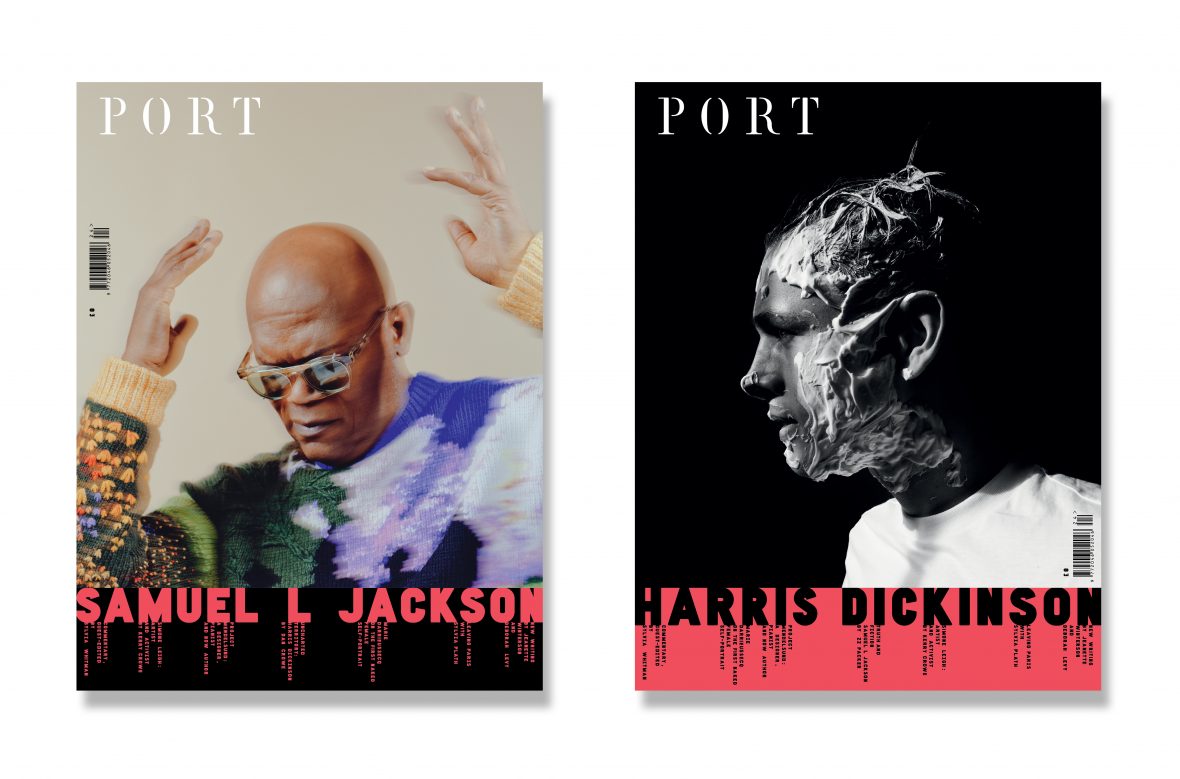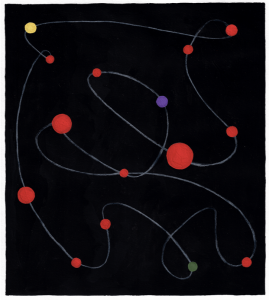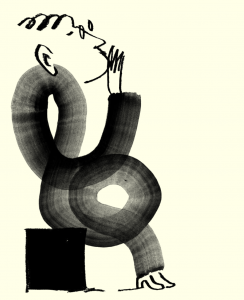An essay by Jeanette Winterson. This was originally published in Issue 24’s Commentary, Guest edited by Sylvia Whitman.
I first met Jeanette in 2007 when I invited her for tea at the bookshop. Desperately nervous and excited, I attempted to bake her three cakes but then my oven at home broke, so I had to cycle to the bookshop’s kitchen, cake mixture spilling out of my basket. As Jeanette was arriving, my father threw a book at her head from his third-floor window. He didn’t miss. Yet still she visits us. I think she likes the theatre of it; bookshops are homes for the romantic and curious minded. Pound said that poets need an uninterrupted curiosity to be able to write anything important. I think that goes for readers, too. The best feeling is when you put down a book and see your surroundings as if for the first time. This is always the sensation I have after reading anything by the formidable Jeanette Winterson.
The roses had the look of flowers that are looked at…
TS Eliot – Burnt Norton
No 1 of Four Quartets
When did you last really look at something? And what was it?
Some time ago a woman who wanted to get my attention came to my house. I knew her a little and I liked her well enough. She was personable and attractive. And that’s all.
It was a blowy autumn evening. Chilly for the time of year.
I went to get us a drink. When I returned she was standing close to the fire. Naked.
There was a pause. I said: What do you want me to do?
She said: Look at me.
It was a powerful act. It is a powerful image. I did look. And as a writer I thought about what it is to be a painter. I thought about looking as an event – a spectacle (and that we used to call eyewear ‘spectacles’), and I thought about looking as translation; the way we interpret what we see.
Anais Nin: We don’t see things as they are, we see them as we are.
Mostly, we don’t look. The brain works hard to absorb the world at the level of familiarity.
What is known is filed. This is a useful evolutionary survival mechanism. Our routes and routines don’t need attention, and in theory that frees us to be alert for what does need attention. In practise we live in a fog and a blur, not noticing our surroundings, or even our loved ones. You don’t notice me anymore is the sad beginning of the end of a relationship.
Remember when you fell in love? How you mapped every millimetre of the beloved? Your forensic obsession with detail? And how the world itself became magnified; the curve of the stone wall, the flight of a bird, the sun rising, the geometry of the city, the wave function of crowds? You saw it all instantly and clearly and with rapt attention. And you saw yourself.
Remember your new baby. All babies look alike. Not so. Your baby is unique. The baby looks at the mother. The mother looks at her child. What do they see? They see the world since time began, this gaze, ubiquitous but unique. They see each other. The bond is intense because it is physical, but also because the mother is an eagle now. Who else can see what she sees?
And what do we see? The onlookers? We see a mother and child. In every picture gallery, in every church, and in homemade shrines all over the world, we find images of the mother and child. This ancient, profound symbol, at once religious and primitive, transcends time and even transcends the impulse that made it.
As an image it represents the cornerstone of human life.
As a symbol it does more than represent, however beautifully, what we know. A symbol is a multidimensional, immersive, contemplative, nonverbal encounter at the sea-edge of conscious and unconscious knowledge – and here I mean knowledge as gnosis – in the sense that Greek thought had a name for the kind of knowing that is a constellated out of what you have learned, what you have experienced, and what you intuit.
This fullness of knowledge is provoked by whatever has symbolic as well as representational value. There are moments we have experienced, gazing at a work of art, gazing into the face of a beloved, whether lover or child, gazing out to sea, or in some profound contact with nature, when life seems to come together. There is unity. There is peace.
For some this happens with music or poetry, when the busy world disappears and the inner eye is free to see into the life of things.
There’s a story about Picasso’s famous portrait of Gertrude Stein. He was having a terrible time painting her head – in fact he had to finish it when she wasn’t there – but she had advised him: Paint what is really there – not what you can see, but what is really there…
This was good advice against representation.
Representation can only take us so far – and certainly not into the life of things.
Right now, in our world, we live on the surface as never before. We are bombarded with visual images designed to sell us stuff. Models are photoshopped out of all reality. Youth is the only timeline with any status. The daily air raid of images, bombing us from billboards and phone apps, isn’t representational; it’s fantasy. All we can do, if we want to keep sane in this fantasy world, is to shut it out. But all around us too, is human misery; homelessness, ugliness, a hostile built environment, a polluted planet. We shut that out too. And in the city, we don’t make eye contact. Above all, don’t smile at strangers. Beggars? Look away. We walk down a street of blank stares.
And when we look in the mirror? Not many people like what they see – or they work obsessively to hone and tone what they see to conform to a fantasy
But where, then, can we rest our gaze? What are we supposed to look at?
Actually? TV. Hours of it. Our avoidant look-away world fetishes the screen. Observe the family at dinner, each busy with their personal screen. Observe ourselves on a train or on the metro, not reading a book or talking, but screen watching.
I love technology and what it has allowed. I hate what we are becoming; unable to focus, unable to fix our eyes on an unmediated image. All the content on your screen is mediated.
Try this. Take any object – an ordinary coffee cup. A spoon. A bucket. Sit with it for 10 minutes and do nothing but look at it. This is why any object is suitable for meditation. First we find how hard it is to concentrate when there is no story and no distraction. When the narrative pattern-making part of the brain is not involved. When there is no sex, no violence, no arousal or affect of any kind. Second, we realise how weird objects are when divorced from context (what the hell is a tie?). Then we begin to pierce the veil of unreality (the unreality of our lives). This is agitating. Then it is calming.
After this exercise with any ordinary object, try it with an object of significance. Like the moon. Or a tree. Try it sitting opposite your beloved. Looking into each other’s eyes.
And try it with a work of art. This is truly scary. I don’t think many of us would last 10 minutes with the Mona Lisa. Any fool can stand there gawping and waving an iPad. That’s not an encounter; that’s avoidance. There are lots of people who avoid art by looking at it via their device. But art is not an Instagram account. You have to be there. (Be Here Now.) And that is harder than it seems.
I try to look at something every day. That is harder than it seems. I want to keep my eyes open. To notice what is around me, whether I like it or I don’t. But I want to go beyond that too, and seek out what has a symbolic value, so that I can understand myself as part of history, as part of the imaginative life of the human race against time.
When I am in Paris I like to go to the Musée de Cluny to look at the six tapestries of the Lady and the Unicorn, woven around 1500. One of these tapestries is called Sight. This series has been endlessly explained and yet it remains mysterious and unknown. To sit in the half dark with those woven images is both to dream and to awaken.
In my dream I become part of the non-time of the tapestry. I am released from my own clock-bound life segments. I am free. Simultaneously I experience an energetic contact – I suppose it is gnosis – outside of the envelope of myself. I am not sleep-walking, I am awake. I see into the life of things.
It is clear to me as I sit with the lady and her unicorn that humans communicate best through noncommunicable forms. That is what art is; not representation, not documentary, not linear, not time-bound, not common sense, not really open to explanation no matter how well we explain it.
And it is worth trying to explain – always – that the human mind is as mysterious as this lady and her unicorn.
Looking.
Sometimes I am just looking for the right road. Sometimes I am looking for an address. Sometimes I am looking for something to wear. Sometimes I am looking at those shapes we call the written word. Sometimes I am looking at you. Sometimes I am looking at myself as time changes me, as it must.
And sometimes, because I keep working at it, and life is a lot of work, I get to see what it is I am looking at, and then I get to see deeper. Like space there is no end.

This article is taken from issue 24. To buy the issue or subscribe, click here




